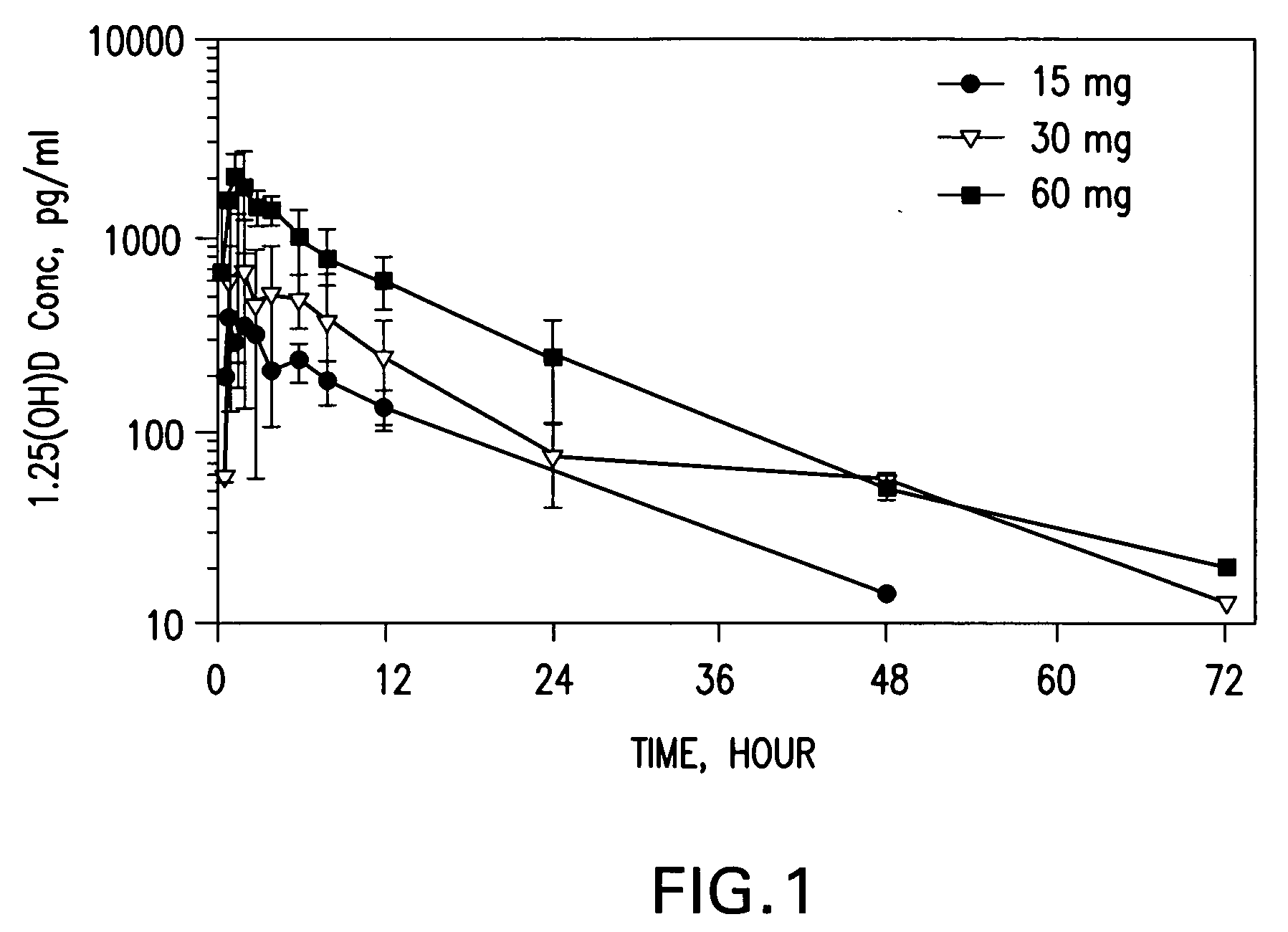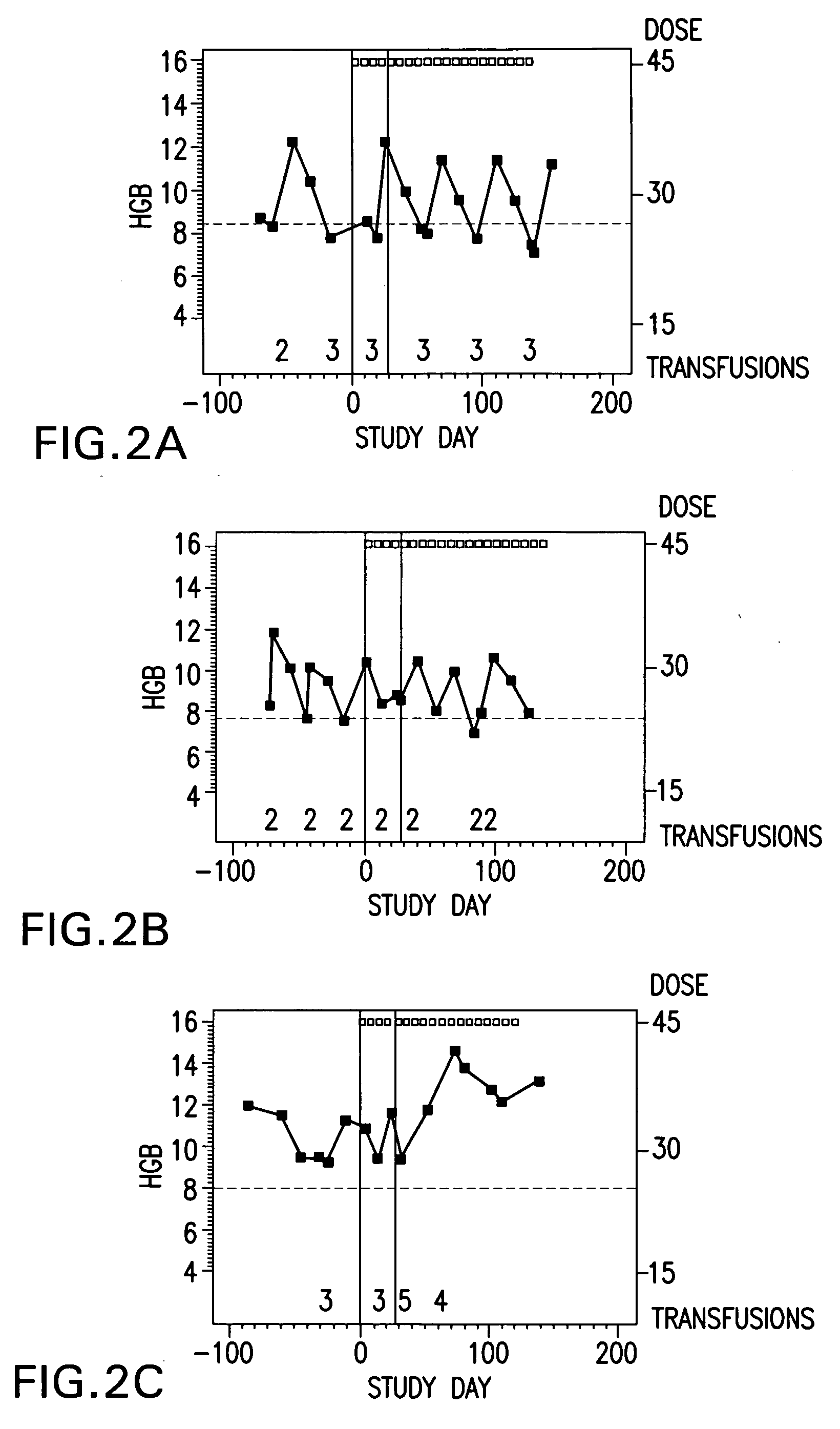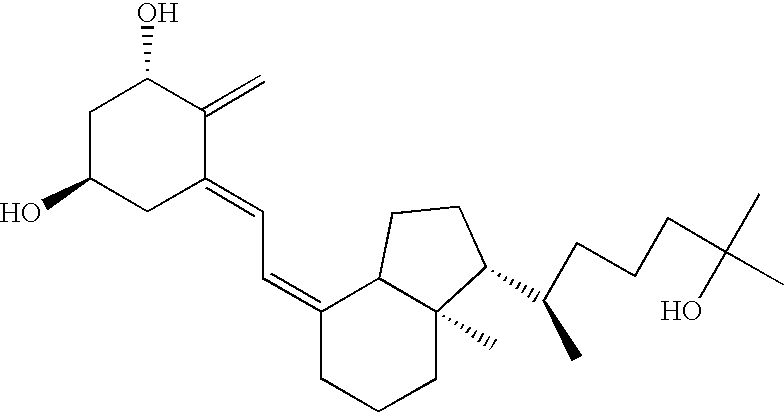Methods of using vitamin D compounds in the treatment of myelodysplastic syndromes
a technology of myelodysplastic syndrome and vitamin d compounds, which is applied in the field of myelodysplastic syndrome treatment methods, can solve the problems of variable risk of progression to acute leukemia, ineffective blood cell production, and morphology and maturation, and achieve the effect of minimizing or avoiding the effects of hypercalcemia
- Summary
- Abstract
- Description
- Claims
- Application Information
AI Technical Summary
Benefits of technology
Problems solved by technology
Method used
Image
Examples
example 1
Pharmacokinetics of Calcitriol Administration
[0245] Twelve human subjects received various amounts of calcitriol in a study designed to determine the pharmacokinetic behavior of the preferred calcitriol oral dosage form. The preferred oral dosage form (“the preferred formulation”) comprises about 15 μg of calcitriol in addition to the following excipients with the amount given in approximate percentage by weight: 65% MIGLYOL 812N®, 30% GELUCIRE 44 / 14®, 5% vitamin-E TPGS and about 0.05% each of butylated hydroxytoluene (BHT) and butylated hydroxyanisole (BHA). Three of the subjects received 15 μg, three received 30 μg, and six received 60 μg of the preferred formulation. Blood samples were obtained pre-dose and at 0.5, 1.0, 1.5, 2.0, 3.0, 4.0, 6.0, 8.0, 12.0, 24.0, 48.0 and 72.0 hours after the initial dose (“post-dose”) of the preferred formulation. Calcitriol levels were analyzed using a commercial radioimmunoassay. Mean plasma concentration vs. time curves were plotted for each g...
example 2
Vitamin D Monotherapy
[0248] The following treatment program provides an example of use of the above-described methods to treat MDS, or ameliorate a symptom thereof.
[0249] Subjects self-administer the preferred formulation, which comprises about 15 μg of calcitriol, in addition to the following excipients with the amounts given in approximate percentage by weight: 65% MIGLYOL 812N®, 30% GELUCIRE 44 / 14®, 5% vitamin-E TPGS, and about 0.05% each of butylated hydroxytoluene (BHT) and butylated hydroxyanisole (BHA). The total dose administered is 45 μg of calcitriol, or three 15 μg capsules, once per week, taken all at once. The subjects are monitored every other week, and the frequency of administration or dosage of calcitriol may be modified accordingly during the duration of treatment.
[0250] Monitoring of the subjects comprises physical examination, ECOG performance status, hematology, anemia work-up, hematology, blood chemistry, urinalysis, study drug administration, transfusion re...
example 3
Vitamin D Combination Treatment Program
[0251] The following treatment program provides another example of use of the above-described methods to treat MDS, or ameliorate a symptom thereof.
[0252] Subjects self-administer the preferred formulation, which comprises about 15 μg of calcitriol, in addition to the following excipients with the amounts given in approximate percentage by weight: 65% Miglyol 812N®, 30% Gelucire 44 / 14®, 5% vitamin-E TPGS, and about 0.05% each of butylated hydroxytoluene (BHT) and butylated hydroxyanisole (BHA). The total dose administered is 45 μg of calcitriol, or three 15 μg capsules, once per week, taken all at once. The subjects are monitored every other week, and the frequency of administration or dosage of calcitriol may be modified accordingly during the duration of treatment.
[0253] Monitoring of the subjects comprises physical examination, ECOG performance status, hematology, anemia work-up, hematology, blood chemistry, urinalysis, study drug adminis...
PUM
 Login to View More
Login to View More Abstract
Description
Claims
Application Information
 Login to View More
Login to View More - R&D
- Intellectual Property
- Life Sciences
- Materials
- Tech Scout
- Unparalleled Data Quality
- Higher Quality Content
- 60% Fewer Hallucinations
Browse by: Latest US Patents, China's latest patents, Technical Efficacy Thesaurus, Application Domain, Technology Topic, Popular Technical Reports.
© 2025 PatSnap. All rights reserved.Legal|Privacy policy|Modern Slavery Act Transparency Statement|Sitemap|About US| Contact US: help@patsnap.com



